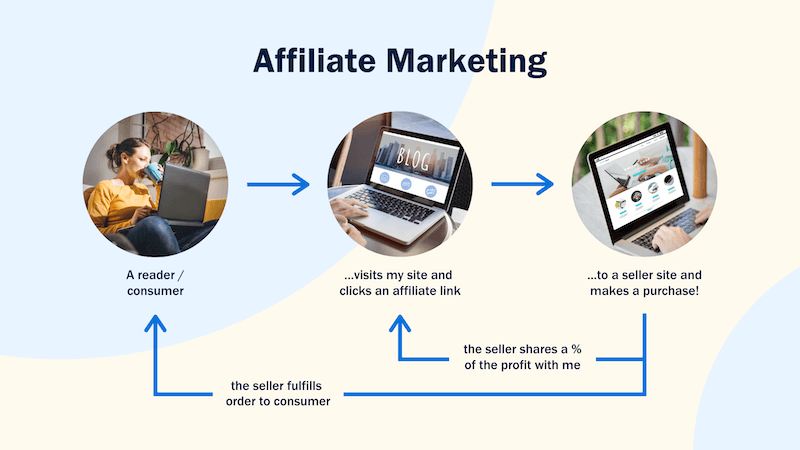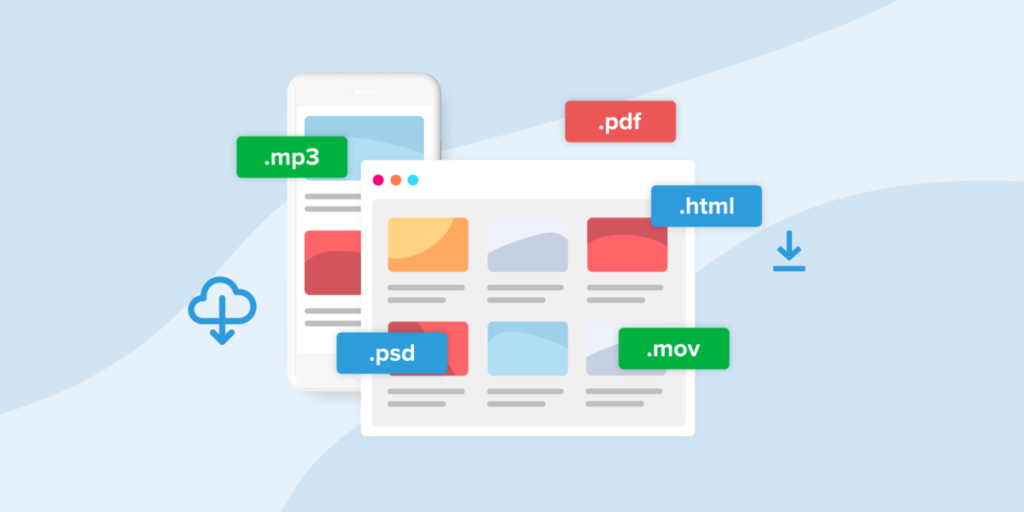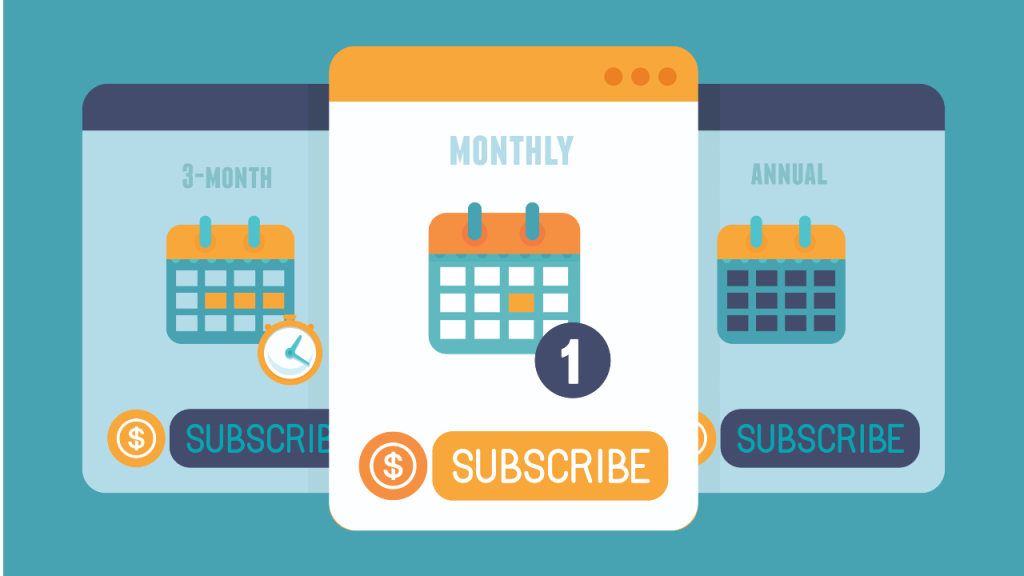There are many ways to monetize your blog. Find out about popular ways to make money with your blog through online revenue models.
It’s never too late if you already have a website or blog and are thinking about starting one. There are many ways to make money from a blog. This article will discuss the most popular digital content monetization strategies and online revenue models.
Let’s begin with the basics. What is monetization? Simply put, monetization is making money through your website. Monetization is when you make money from your blog’s online content.
There are many online business models that can help you make money with your blog.
- Advertisement
- Affiliate marketing
- Offerings of physical and digital products
- Subscribe to our Newsletter
- Coaching
These monetization models can work for your blog. Let’s look at each model of monetization.
Advertisement monetization: To make money, you can offer advertising on your blog

Advertising can be a good way to generate revenue as a blogger. Advertisers will pay for exposure to your audience. Advertisers can pay more for a newspaper that has a larger circulation. The more popular your website and content, the more you can make.
Businesses that wish to appear on your website alongside your content can be offered advertising space. This is called a direct agreement. An ad network, such as Google AdSense, can be used to sell your advertising space for you.
AdSense serves ads that are related to content on your blog pages. AdSense may show you an advertisement about Icelandic travel insurance or warm clothing if your blog is all about adventure travel. AdSense pays you if a user views an ad or interacts with it.
Many advertisers will pay more for your ad space if you can make your online ads relevant to your blog’s content and readership.
Affiliate marketing: Make money through product recommendations

Affiliate marketing is when you include a link in your content to a product or service for sale on another site. Here’s how it works: when someone clicks the link on your site, goes to the affiliate’s site and proceeds to buy the product you’ve endorsed, you earn a commission on the sale.
This can be a good revenue model for blogs that have a large audience and are interested in product recommendations. Affiliate products can be promoted in many ways, including lifestyle, informational and how-to articles.
Let’s take the adventure travel blog as an example. You might have written a story about wild swimming spots. Affiliate marketing could be used to promote the gear you brought on your trips, such as a towel, swimsuit and goggles. Your blog can generate income if a reader clicks on the link and buys the swimsuit that you recommend.
Transparency about your affiliate relationships is key to maintaining trust with your audience. It is a requirement in many countries to disclose affiliate relationships. If you are interested in affiliate marketing, make sure to consult with legal counsel. Remember that the reputation of your blog and the product or service you promote are directly related, so choose quality affiliate partners.
You can sell physical or digital products through your blog

As a way of monetizing their blogs, many bloggers establish a presence on an eCommerce platform, create an online store, and start selling products. Your products could be physical or digital. In the example of the adventure travel blog, you might sell t-shirts displaying your logo or digital guidebooks for exotic destinations.
You will need to establish a payment system, regardless of whether your products are physical or digital. You must think about how to store your inventory, organize shipping, and handle taxes and duties when selling physical merchandise. Because digital goods can be delivered electronically, logistically they are less complicated.
Subscribe to receive a monthly income stream by paying a subscription

If your blog has an active community that’s eager to know more about your subject, a paid membership or subscription model is another way to use your valuable content to generate revenue over the long run.
This business model requires readers to pay a fixed amount each month or year. This business model allows you to generate recurring income by collecting subscription fees or membership fees from your readers. This type of steady cash flow can provide a stable, predictable, and reliable revenue stream.
You might offer members or subscribers premium content, a community, learning resources, videos or other services in exchange. These elements can be combined to make your blog more appealing.
Coaching: Make your blog profitable through training

If your blog lends itself to training services, you could earn money by setting up and charging for online courses or coaching packages.
You can create self-guided learning materials, such as videos and downloadable ebooks that allow your audience to move at their own pace. You can track the interest of your students as they progress through your course.
It can take a lot of time and resources to create an online curriculum. To make it work, you will need to engage your audience.
You can also offer live video coaching to increase your income and get paid for your time.
You can offer an online course, on-demand coaching, or both. However, you may also want to include communication opportunities with students via email or your blog.
You have many options for making money with your blog. One blog monetization strategy can be used, but you can also mix and match revenue streams to find the best fit for your business.
Blogging platforms for free

Ideal for: Casual bloggers, and those who are not interested in making money with their blog.
Pros are Very easy to set up and totally free.
Cons. Limits on customization, video/image uploads and affiliate links. You can’t often place ads or use affiliate hyperlinks. A custom URL can’t be created and the platform can delete your blog.
A lot of platforms will allow you to set up a blog for free, and they’re super easy to use. If you’re just wanting to blog casually at first, this could suit you well.
However, some free blogging platforms are very restrictive. Your blog will be limited in its customization capabilities. Also, it may have a storage limit that makes it difficult to upload large images and videos.
Another drawback is that your blog URL will be something like ‘www.yourblog.wordpress.com’ with the platform branding.
Many free blogging platforms don’t permit you to place affiliate links or banner ads on your site. These are important revenue streams that most bloggers use.
If you don’t mind these things, here’s a list of the top free blogging sites.
Best blogging sites
- WordPress.com This free basic blog hosting service is easy to use. If you don’t pay a monthly fee for WordPress, you will have to accept branding and WordPress ads. You can’t place ads on your website. You also have limited options for customization and expansion.
- Blogger Blogger is a free blog hosting service from Google. It’s very easy to use. However, there are not many options for customisation or design.
- Medium Medium focuses more on writing than design. Medium is used by many journalists, writers, and experts. It’s a great way for you to share your work with a specific community. It’s not possible to run ads or create your personal branding.
Build your own website

The best for Dedicated bloggers and people looking to make a living with their blog
Pros: You have complete control over design and customization, your own URL and the ability to use affiliate links and adverts however you wish
Cons: First, you’ll need to pay for your domain name (URL), then for hosting. However, we have tips for affordable web hosting.
If you’re not particularly tech-savvy, the thought of creating your own website might seem quite scary – but it’s actually pretty easy to do, and you can create one in just 20 minutes.
Owen, Save the Student founder, has created a step-by-step guide that will show you how to create a website.
You can create personal branding with your own website.
WordPress offers an incredible number of themes or templates. Take your time and choose one that suits your personality and your blog’s topic.
Choose something simple with large images and easy-to-read fonts.
How to choose a topic for a blog

This is either the most difficult or easiest part of starting a blog.
The most important thing is to pick a niche in which you are an authority. This is the biggest mistake that new bloggers make in such a crowded blogging world.
For example, if fashion’s your thing, instead of combining generic fashion content, you could combine your love for clothes with your big-hearted concern for the environment by blogging about environmentally-conscious designers instead?
These are the top ways to find a topic on your blog.
- You should look at other blogs. What is working? What’s more, what’s not working? Locate the market gaps.
- Google – What are people looking for? Google suggests searches and auto-complete can be used to find what people are searching for. If they search for it, it means that there is a demand.
- Forums are a good place to search for common FAQs. What are they looking for? What are they looking for advice? This will reveal what people are most interested in and what information is lacking.
- Follow current trends – What are the most popular topics in the media? While it’s important to choose a topic that will last, you should be able to jump on any trend and quickly become an expert. You can search #journorequest to see what themes journalists are covering.
- You can think about the different types of content. Could you make tutorials/how to guides? Reviews? Interviews? Lists? Lists?
- Identify your passions and interests – Although all the above is important, it’s not a good idea to blog about things you don’t care about. People will notice your lack of enthusiasm and quickly become bored. You should write about something that you truly, deeply care about.
How to Increase Your Blog Traffic

After you have created your website and chosen a blog topic, you can publish your first posts. Now the big question is: Where are all the readers?
It is not enough to expect people to find your blog by chance. It must be promoted!
These are the easiest and best ways to increase your blog’s readership:
- Social media is a great place to promote your blog: You won’t get noticed, as with all businesses nowadays, if your social media accounts aren’t there.It’s a good idea to set up pages/accounts on Facebook, Twitter and Instagram. These accounts should be designed in the same colour/theme as your blog to make your brand consistent and easy to recognize.Use them to share new posts and tag fellow bloggers/influencers/companies who might share your content and help it to reach an even bigger audience.To help your blog reach more people, you could do paid advertisement or host a contest to get more likes. Keep your followers interested once you have established a following. Post on a regular basis, not just for new posts.
- Get in touch with other bloggers: Be known to others who blog on similar topics. Although you may be technically a competitor, it is likely that you will be pleasantly surprised at how supportive the blogger community can actually be.Many bloggers have a link page that they link to their community friends in exchange for their own link. This will greatly improve your SEO (search engine optimization – how likely is your blog to appear in Google searches).You can engage with other bloggers by sharing their content and they will likely reciprocate the favor. Perhaps you could even collaborate!
- Your blog can respond to news stories: Get involved if something is happening in the news that is relevant to your niche. This is known as newsjacking and can help you get some amazing exposure.If you blog about student cooking then keep your eyes peeled for the unveiling of our latest student money survey. You can show students how to save money while eating better food, even though they might spend on average PS101 per month. ).Social media allows you to share your thoughts with the right hashtags and participate in discussions. You can even reach journalists to let them know that you are available for comment.Journalists might be interested in you if you are a master at your niche.
- Make viral content: You can reach new markets by creating viral content. This will increase your readership.Although this may seem difficult, the key to creating viral content in your niche blogging field is to tap into controversial and highly-discussed topic – as you can see, this often involves newsjacking as described above.This niche is what you will be passionate about, and you will be knowledgeable about it. People will want to read, share, and discuss your opinion.
How to make money blogging
1. Affiliate marketing can help you make money
Affiliate marketing involves recommending a product or service via special tracking links to your audience and receiving a referral commission each time they buy after clicking your link.
An example of affiliate marketing is when you help someone open a bank account at your branch. They usually give you a gift certificate or bonus.
Affiliate programs are available for many services and products online. Affiliate programs are available for any industry or niche.
You can begin affiliate marketing by looking at products that you have used and which you think your readers might be interested in. You can then check to see if the company has an affiliate program you can join.
There are many products that you can promote:
After you have chosen the products you want to promote, you can then use a WordPress plugin such as PrettyLinks for managing your affiliate links.
You can insert links quickly into posts, create branded hyperlinks, auto-replace keywords in links, and even monitor how each link performs on your site.
Because you can promote many products, affiliate marketing is one of the most effective ways to make money. Affiliate programs are available at most popular stores like Amazon, BestBuy and Walmart.
For more information, please visit our beginners guide to affiliate marketing. Also, check out these plugins that will help you increase earnings.
2. Display Google AdSense on WordPress
Google Adsense can be used to make money with your blog. You can add a Google script to your website to start displaying ads.
For every click on an ad, you will be paid. These ads are known as CPC ads.
What’s CPC? CPC is an acronym for cost per click. You can display CPC ads using Google Adsense and receive a set fee each time a visitor clicks on your ad.
Advertisers set the cost per click. This is in contrast with CPM ads where you are paid for clicks and not ad views. CPM stands for “cost per thousand impressions,” and M is the roman numeral that represents 1,000.
Google Adsense can be a great way to make money online, especially if you’re just starting out.
To get started, you can read our How to Monetize a WordPress Blog with Google AdSense. For more information, see this tutorial on How to Optimize AdSense Revenue.
Are you looking for an alternative to Google AdSense? Media.net is an alternative to Google AdSense. You also get a lot of advertisers and good payouts.
3. To sell ads directly, use a WordPress advertising plugin
Google AdSense can be set up quickly, but you are limited in the amount of money that you can make. Earnings from each ad click will be different.
It can be more profitable to sell banner advertising space directly on your website. You negotiate the terms and price of your banner ad space on your website, instead of relying on an intermediary who takes a cut.
We have already discussed the differences between CPC ads and CPM ads. CPC ads are where you get paid per click or per thousand impressions. You could also use these models to sell banner ads but most bloggers charge flat rates. It is much easier to charge a flat fee than keep track of clicks or views.
However, selling ads directly requires more effort than using Google AdSense. You won’t be able to add a little code to your site. Instead, you will need to negotiate the price, agree on terms and complete administrative tasks like billing.
However, a WordPress Ad Management plugin may make it easier. We recommend AdSanity as it allows you to manage both Google AdSense and your own ads.
For more information, please visit our guide on how you can sell ads on your WordPress site.
4. Promote Sponsored Blog Posts
Bloggers may not be interested in showing ads to their readers and are curious about how to monetize blogs without advertising.
You lose some control over what content is displayed on your website when you use ad networks. Ads can be irritating or offensive to some readers. Ad-blocking software is becoming more popular, which could impact your earning potential.
Sponsorships are another way to make money from a blog.
Sponsorship works in the same way as it does on TV, sports and other industries. A company pays you to promote their product and talk about it.
It’s a good idea for you to create a media kit of one page that includes information about your traffic stats and social media followers, audience demographics, as well as any other data that can make your site more attractive to advertisers. You can then approach companies to discuss a sponsorship deal.
It is important to be familiar with the laws in your region regarding disclosure when publishing sponsored posts.
A sponsored post published by a blogger in the United States must conform to the FTC Endorsement Guides. This includes disclosing whether a post has been sponsored. Adding a sponsored post prefix in WordPress can help you do this.
5. Reviewers get paid to write reviews
You can make money writing paid reviews on the site, just like sponsored posts.
This monetization method is slightly different than that of a review website with affiliate links.
Instead, you can get products in your niche free of charge, and even earn money for reviewing them.
This process can be very similar to the review of sponsored posts. Review products that you are interested in and relevant to your niche.
To inquire about paid reviews, you can also approach the companies directly. You can also use websites such as PayPerPost to find businesses that might be interested.
6. Flipping websites can make you money online
You’ll be way ahead of the rest if you understand how to build a WordPress site. Entrepreneurs sometimes prefer to purchase websites they already own that they can use for their businesses.
You can create a WordPress blog, get traffic to it, and then sell it.
Knowing the types of websites that are in high demand and how to price them and sell them is essential. Websites like Flippa can be used as brokers and auction sites for websites.
7. As an Influencer, get public speaking gigs
You will build a following by promoting your brand alongside your blog and establish yourself as an influential figure in your field.
This recognition can be used to land a job as a public speaker. Speaking at conferences is a popular way for bloggers to make a lot.
Speaking at events, regardless of whether you’re paid, can help you promote your blog as well as your personal brand. You will be able find many new opportunities if you are good at public speaking and networking.
These are some tips to help you make money as a public speaker.
- Be an expert in your area. Start learning if you don’t have the right knowledge/skills.
- Be consistent – It is important to promote your knowledge on the topic via your blog and social media.
- Let others know you are available. You can either announce via social media or contact event organizers privately.
- It is possible to not immediately find paid speaking gigs. Many speakers who are successful start their public speaking careers at smaller, casual and more informal events in the community.
Make a paid membership website
There are many other ways to make money online if you don’t want to sell ads or sponsor posts. One popular way to make money online is to charge your visitors for access to certain areas or content on your website. These are just a few ways you can do it.
8. Restricted members-only content
These are your most loyal readers. They may be fans of your work and willing to pay more. For members, you can make it easier to share in-depth blog posts and downloads.
Because you have to create premium content for your members, membership sites can be time-consuming. They can also be very profitable because of their recurring revenue (subscriptions).
A WordPress membership plugin can be used to create a membership website. We recommend MemberPress as it is the most user-friendly and robust WordPress membership plugin.
This complete guide to creating a WordPress membership site includes step-by-step instructions that will help you get started.
9. Start a Private Forum
You can also create private forums for paid members. This is another option. Forums allow your audience to receive one-on-one guidance from you. You can also help out other members of your community by interacting with them.
Moderating forums can be time-consuming, but a paid forum is an excellent way to generate recurring income from your WordPress website.
You will need to create a forum for your site in order to get started. These are our top 5 favorite forum plugins for WordPress.
10. Make a community of questions and answers
Stack Exchange and Quora, which offer question-and-answer communities, are very popular. These communities help you create an online community that is motivated, driven, and engaged.
You will need to invest some time in building a large community, just like forums. You will then be able to make money from user-generated content by using affiliate ads and other methods.
Popular question and answer sites can get sponsorship and direct advertising deals from companies in their field. They can negotiate a higher rate and additional perks.






















